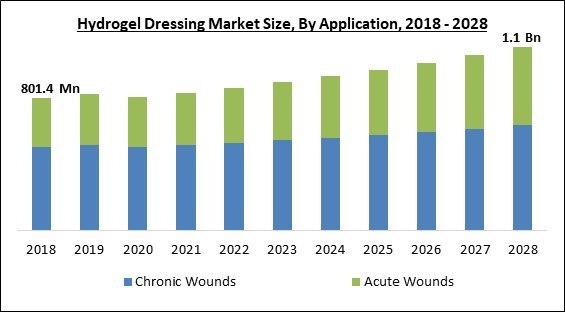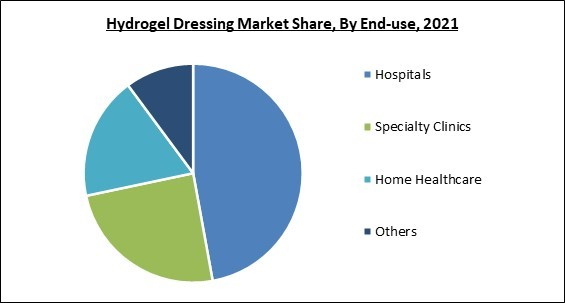The Global Hydrogel Dressing Market size is expected to reach $1.1 billion by 2028, rising at a market growth of 4.2% CAGR during the forecast period.
Semi-occlusive hydrogel dressings are constructed of hydrophilic polymers with a high (90%) water content. Hydrogels are intended to hydrate wounds, rehydrate eschar, and facilitate autolytic debridement. Hydrogels are refractory polymers that expand in water and are accessible as sheets, amorphous gels, or dressings impregnated with sheets of the hydrogel. Hydrogels offer a wet environment for cell motility and absorb some waste.
Hydrogel dressings offer the additional benefit of autolytic debridement without harming granulation or epithelial cells. Hydrogels are advised for dry to mildly exuding wounds and can be utilized to break down slough on the wound surface. Hydrogels have a significant cooling and calming impact on the skin, making them useful for treating burns and severe wounds.
In addition to their utility in treating wounds, thin hydrogels are also effective in treating chicken pox and shingles. Purilon and IntraSite gel are two of the thicker gels available to aid the substance remaining in the wound's cavity, while Solugel and Solo's site are two of the thinnest for simple application over a broader area. The wound is generously coated with amorphous hydrogels and then covered with a secondary dressing such as foam or film.
Hydrogels can stay in place for up to three days. Hydrogels are indicated for dry, sloughy wounds with mild exudate and partial thickness wounds. Moist hydrogel dressings, included in the third most modern dressing generation of materials, are obtained from the mixture of natural polymers (agar-agar, gelatine, pectin) and synthetic polymers (poly(vinyl pyrrolidone) and poly(ethylene glycol) that were placed in commercial packagings and sterilized by the electron stream or gam Most frequently, hydrogel dressings are applied to burn wounds, as well as traumatic wounds, ulcerations, and bedsores.
They may be applied to any area of the body because of their remarkable flexibility. The removal of the hydrogel dressing is quick and painless. Regeneration and repair of the skin during treatment with this type of dressing occur more rapidly than with standard dressings.
The market research report covers the analysis of key stakeholders of the market. Key companies profiled in the report include Cardinal Health, Inc., Smith & Nephew PLC, 3M Company, Coloplast Group, ConvaTec Group PLC, Medline Industries Inc., Integra LifeSciences Holdings Corporation, McKesson Corporation, DermaRite Industries, LLC, and AMERX Health Care Corporation.
Semi-occlusive hydrogel dressings are constructed of hydrophilic polymers with a high (90%) water content. Hydrogels are intended to hydrate wounds, rehydrate eschar, and facilitate autolytic debridement. Hydrogels are refractory polymers that expand in water and are accessible as sheets, amorphous gels, or dressings impregnated with sheets of the hydrogel. Hydrogels offer a wet environment for cell motility and absorb some waste.
Hydrogel dressings offer the additional benefit of autolytic debridement without harming granulation or epithelial cells. Hydrogels are advised for dry to mildly exuding wounds and can be utilized to break down slough on the wound surface. Hydrogels have a significant cooling and calming impact on the skin, making them useful for treating burns and severe wounds.
In addition to their utility in treating wounds, thin hydrogels are also effective in treating chicken pox and shingles. Purilon and IntraSite gel are two of the thicker gels available to aid the substance remaining in the wound's cavity, while Solugel and Solo's site are two of the thinnest for simple application over a broader area. The wound is generously coated with amorphous hydrogels and then covered with a secondary dressing such as foam or film.
Hydrogels can stay in place for up to three days. Hydrogels are indicated for dry, sloughy wounds with mild exudate and partial thickness wounds. Moist hydrogel dressings, included in the third most modern dressing generation of materials, are obtained from the mixture of natural polymers (agar-agar, gelatine, pectin) and synthetic polymers (poly(vinyl pyrrolidone) and poly(ethylene glycol) that were placed in commercial packagings and sterilized by the electron stream or gam Most frequently, hydrogel dressings are applied to burn wounds, as well as traumatic wounds, ulcerations, and bedsores.
They may be applied to any area of the body because of their remarkable flexibility. The removal of the hydrogel dressing is quick and painless. Regeneration and repair of the skin during treatment with this type of dressing occur more rapidly than with standard dressings.
COVID-19 Impact Analysis
During this period, a significant decline in the automated dressing market was seen. Also, during the COVID-19 lockdown, everyone except frontline employees and essential service providers stayed at home, resulting in a significant decrease in the number of traffic accidents and other injury-causing variables. As a result, the necessity for dressing devices was reduced. Additionally, the COVID-19 lockdown significantly improved air quality on a scale, with the reduced air pollution induced by a worldwide slowdown in transportation operations serving as a primary driver for the improvement which slow down the pace of the hydrogel dressing market.Market Growth Factors
Increasing Technological Advances In Wound Closure Techniques
The market is being pushed by technical developments in wound closure techniques, such as injectable stimuli-responsive amorphous hydrogels for stopping bleeding in trauma scenarios. In addition, the expanding elderly population, better healthcare infrastructure, and advancements in remote monitoring technologies for advanced wound care devices. Government initiatives focused on increasing diabetes patients' understanding of diagnosis and treatment.Hydrogel's Chilling Effects
By its water content, hydrogel dressings provide a cooling impact on the wound that promotes analgesia and is theorized to diminish the inflammatory response. Consequently, the application of hydrogel dressings to wounds results in practically instantaneous pain relief. The cooling effect can persist for around six hours and has been demonstrated to be very useful for burns and partial-thickness wounds.Market Restraining Factors
The Availability Of Alternative Products
Topical skin adhesive and Sealing agents such as human fibrinogen, thrombin fleeces, gelatin sealants, and fibrin sealants, as well as devices such as wound closure strips,ligating clips,and stapling devices for wound closure, are the ideal substitutes for surgical dressings. In the event of elderly patients with fragile skin, these solutions offer a painless experience and improved closure. For lesser lacerations, strips and tapes are a suitable substitute for dressings.Product Outlook
Based on the Product, the Hydrogel Dressing Market is segmented into Amorphous Hydrogel, Impregnated Hydrogel, and Sheet Hydrogel. The amorphous hydrogel segment acquired the highest revenue share in the hydrogel dressing market in 2021. A hydrogel dressing is applied to a dry wound to give moisture and maintain a wet healing environment. These bandages are often used to treat small burns, necrotic wounds, and radiation-damaged tissue.Application Outlook
On the basis of Application, the Hydrogel Dressing Market is divided into Acute Wounds and Chronic Wounds. The chronic wounds segment procured the largest revenue share in the hydrogel dressing market in 2021. The dominance can be attributed to the increase in the senior population, the number of patients with diabetic foot ulcers, and obesity. It is anticipated that the increase in the number of persons with obesity would increase the number of patients with pressure sores and venous leg ulcers.End-use Outlook
On the basis of End-use, the Hydrogel Dressing Market is fragmented into Hospitals, Specialty Clinics, Home Healthcare, and Others. The home healthcare segment recorded a significant revenue share in the hydrogel dressing market in 2021. As a result of a rise in patient demand, hospitals are giving way to home care options. Most surgical treatments have a protracted recovery period, necessitating frequent dressing changes.Regional Outlook
Region-wise, the Hydrogel Dressing Market is analyzed across North America, Europe, Asia Pacific, and LAMEA. The North America segment garnered the largest revenue share in the hydrogel dressing market in 2021. Large populations and rising patient pools in nations such as the United States and Canada are the primary drivers driving the growth of the hydrogel dressing sector in this region.The market research report covers the analysis of key stakeholders of the market. Key companies profiled in the report include Cardinal Health, Inc., Smith & Nephew PLC, 3M Company, Coloplast Group, ConvaTec Group PLC, Medline Industries Inc., Integra LifeSciences Holdings Corporation, McKesson Corporation, DermaRite Industries, LLC, and AMERX Health Care Corporation.
Scope of the Study
By Application
- Chronic Wounds
- Diabetic Foot Ulcers
- Pressure Ulcer
- Venous Leg Ulcers
- Others
- Acute Wounds
- Surgical & Traumatic Wounds
- Burns
By End-user
- Hospitals
- Specialty Clinics
- Home Healthcare
- Others
By Product
- Amorphous Hydrogel
- Impregnated Hydrogel
- Sheet Hydrogel
By Geography
- North America
- US
- Canada
- Mexico
- Rest of North America
- Europe
- Germany
- UK
- France
- Russia
- Spain
- Italy
- Rest of Europe
- Asia Pacific
- China
- Japan
- India
- South Korea
- Singapore
- Malaysia
- Rest of Asia Pacific
- LAMEA
- Brazil
- Argentina
- UAE
- Saudi Arabia
- South Africa
- Nigeria
- Rest of LAMEA
Key Market Players
List of Companies Profiled in the Report:
- Cardinal Health, Inc.
- Smith & Nephew PLC
- 3M Company
- Coloplast Group
- ConvaTec Group PLC
- Medline Industries Inc.
- Integra LifeSciences Holdings Corporation
- McKesson Corporation
- DermaRite Industries, LLC
- AMERX Health Care Corporation
Unique Offerings
- Exhaustive coverage
- The highest number of Market tables and figures
- Subscription-based model available
- Guaranteed best price
- Assured post sales research support with 10% customization free
Table of Contents
Chapter 1. Market Scope & Methodology
Chapter 2. Market Overview
Chapter 3. Global Hydrogel Dressing Market by Application
Chapter 4. Global Hydrogel Dressing Market by End-use
Chapter 5. Global Hydrogel Dressing Market by Product
Chapter 6. Global Hydrogel Dressing Market by Region
Chapter 7. Company Profiles
Companies Mentioned
- Cardinal Health, Inc.
- Smith & Nephew PLC
- 3M Company
- Coloplast Group
- ConvaTec Group PLC
- Medline Industries Inc.
- Integra LifeSciences Holdings Corporation
- McKesson Corporation
- DermaRite Industries, LLC
- AMERX Health Care Corporation
Methodology

LOADING...
Table Information
| Report Attribute | Details |
|---|---|
| No. of Pages | 289 |
| Published | October 2022 |
| Forecast Period | 2021 - 2028 |
| Estimated Market Value ( USD | $ 835 Million |
| Forecasted Market Value ( USD | $ 1109 Million |
| Compound Annual Growth Rate | 4.2% |
| Regions Covered | Global |
| No. of Companies Mentioned | 10 |










